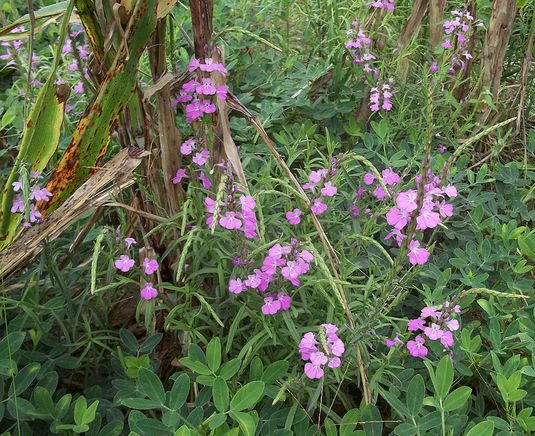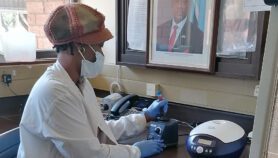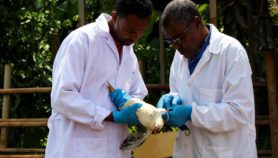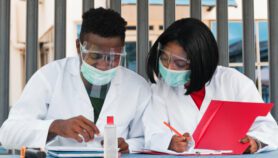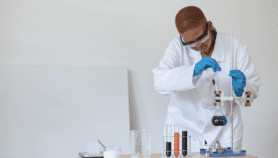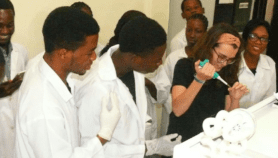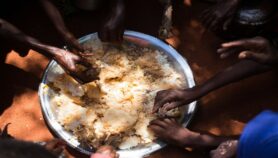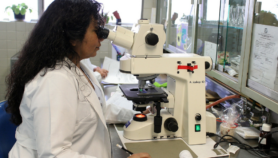By: Nina Dudnik
Send to a friend
The details you provide on this page will not be used to send unsolicited email, and will not be sold to a 3rd party. See privacy policy.
In a three-room lab outside Nairobi, Kenya, cutting-edge science is meeting time-honoured farming practices. Steven Runo, a senior lecturer with a specialisation in molecular biology, and his colleagues at Kenyatta University are using the tools of modern molecular biology to overcome constraints of growing maize, sorghum and rice.
In particular, Runo is using a broad range of genomics and molecular biology strategies to fight parasites such as Striga, which strangle the crops.
The type of research being conducted by Runo, his team in Kenya and other scientists in developing countries is key to food security in the world.
Taming Striga
Striga, also called witchweed, is one of the most destructive weeds for crops in Africa.
“Agricultural research — using both conventional and modern scientific tools — is an integral force in both sustaining and improving the food supply and income across the world.”
Nina Dudnik
The UN Food and Agriculture Organization estimates that Striga causes more than US$7 billion in losses each year worldwide. [1]
Worse, the weed produces thousands of seeds and can lie dormant in the soil for more than a decade. Most farmers within its sphere of impact are reliant on methods such as hand-weeding and crop rotation, and are fighting a losing battle against the parasite.
Striga used to be a problem in the United States too; in the 1950’s the United States Department of Agriculture (USDA) led the fight against Striga. Still today, the USDA offers cash rewards for anyone who identifies the weed in their fields.
Agriculture, just like health, is global. Seeds and people travel, and uncontrolled Striga in East Africa can easily lead to problems in the United States for cereal crops, which account for more than US$60 billion in revenue a year in the country. [2]
Agricultural production is a critical line item in every country’s economy, and is even more urgently relevant to the health and nutrition of a rapidly increasing global population.
Agricultural research — using both conventional and modern scientific tools — is an integral force in both sustaining and improving the food supply and income across the world.
In the 1970’s, the United States and international research institutions led the way to creating a “Green Revolution.” Today, we need to marshal the talents of agricultural researchers in all parts of the world, and consider that a one-size-fits-all approach is no longer relevant to the challenges faced in developing settings.
“Our major goal is to lessen the burden of Striga on smallholder farmers,” says Runo.
“But our work in a broader sense opens up new research tools and human capacity in Kenya.”
Partnerships are key
Runo is starting from a stronger position than many in his cohort. His mentor at Kenyatta University, Jesse Machuka, had spent much of his career working in international organisations, and brought to his students the support of a strong global network. Machuka built a well-equipped lab containing some of the most important tools for molecular biology: RT-PCR, electroporation for the genetic transformation of plants, and a full-scale walk-in incubator.
In building his own international network, Runo was able to secure a position at UC Davis in the United States to conduct much of his PhD research, and attended key conferences in his field, allowing him to further his network to support his work upon his return to Kenya. “Partnerships are instrumental for the success and sustainability of our research,” he says. “We leverage the advanced developments in science from our partner labs and develop joint proposals and publications.”
With the support of this network, funding and publication track record, Runo has made international training available to himself and others, and has started to receive grants independently. His lab still has unmet needs, however, including specialised training in bioinformatics and equipment for studying the microscopic structures of cells and tissues of plants and animals, and measuring the amount of genetic materials, a process called DNA/RNA quantification.
Innovative agricultural solutions worldwide
Runo is not alone. Thousands of scientists around the world are exploring innovative solutions to the global food problem. Many, like him, are addressing issues that can impact agriculture worldwide, and support of their research can contribute not only to regional impact, but solutions that improve food security for the entire world.
“Partnerships are instrumental for the success and sustainability of our research.”
Steven Runo, Kenyatta University
While even the most localised research can have global impact, many developing-world researchers are focused on problems that affect their regions, specifically. Supporting their work can be just as important. Their passion to address the issues facing their communities often drives pioneering research into areas that receive little attention on a global scale.
Researchers in Peru, for example, are studying the epidemiology of parasites that infect local livestock such as alpacas and llamas, according to Daniel A. Z. Rendon, a researcher with La Molina National Agrarian University in Peru.
Deepening their knowledge about patterns of resistance to these parasites and how to control them will increase the welfare of the animals and the livelihoods of farmers working in the hilly terrain of the Andes of Peru.
Over 5,000 miles away, Ibok Oduro and her team in Ghana are quantifying the nutritional properties of historic local crops such as African breadfruit and cocoyam. Although these species have been overlooked lately in favour of more well-known “modern” crops such as rice, Oduro believes that they can fill an important economic and nutritional gap. Locally such crops are cultivated by women; adding value to them could boost women’s earnings and preserve local culinary traditions.
Oduro, who heads the Department of Food Science and Technology at the Kwame Nkrumah University of Science and Technology, Ghana, sees a larger global need being met as well. “The world is turning to organic foods,” she says, “and the development of a novel food product can help meet the demand. These studies will not only benefit Ghana but neighboring countries and the world at large in meeting growing consumer needs and nutrition security.”
Supporting local scientists
The perception that meaningful, productive research only occurs in the gleaming labs of advanced economies is simply untrue.
Scientists in developing countries frequently lack access to the same opportunities and infrastructure that their counterparts in developed settings enjoy, but their unflinching dedication to practical, accessible solutions that leverage regional resources could pave the way to the next great scientific discovery.
Making these investments in their work is critical in our shared mission to maximise the effectiveness and impact of the global scientific community, and will pay dividends to the world for years to come.
Nina Dudnik is a molecular biologist and the founder and CEO of Seeding Labs, a Boston-based nonprofit that has provided lab equipment, tools, and training to scientific researchers in 24 developing countries across Latin America, Africa, and Asia. She can be contacted at [email protected]
This piece was produced by SciDev.Net’s Sub-Saharan Africa English desk.
References
[1] Sulayman Sait Mboob A regional programme for Striga control in West and Central Africa. In: Thomas Oxendale Robson and others (editors) Striga-Improved Management for Africa. Proceedings of the FAO/OAU All-African government consultation on Striga control (FAO, 1989)
[2] Cereal crops in the United States (MarketLine, February 2015)


